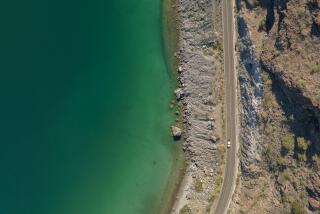India’s Rule of the Road: Just Cringe
- Share via
AGRA, India — There are millions of deities worshiped in India. I didn’t know the name of the icon mounted on the dash of our driver Bhanwar Singh’s car, but when we pulled out to pass the bus in front of us, I prayed it was the God Who Protects Those Who Pass on Blind Curves.
The truck rumbling at us when we came out of the turn was as big as a barn and growing by the instant. The truck driver honked. The bus driver honked. Our driver honked. Nobody braked.
Singh yanked the wheel, aiming the car for the narrowing gap between the two hulking vehicles. We slipped through with only enough spare room for a ray of hope.
It was Day 1 of a 13-day road trip around northwestern India, and our nerves were already as fried as old spark plugs. The 1,200-mile journey took Andrea and me west to Jaisalmer, near the border of Pakistan, before looping east to Agra, where we toured the Taj Mahal. We logged most of the miles in Rajasthan, a desert state studded with forts, palaces and temples.
In Pushkar, where we started, we approached a hotel travel director to ask about train schedules. Ten minutes later, he had our names on a contract for one of the hotel’s Ambassadors--the ubiquitous Indian-made auto that is a cross between a London taxi and a Volkswagen Beetle--complete with a non-English-speaking driver.
Hiring a car and driver at $26 a day, including gas, cost little more than train tickets for two to our planned destinations, the agent said. Plus, we would have local transportation at every stop on our itinerary. What he didn’t disclose was that we would feel like stunt doubles in the chase sequence of a B-grade Indian action film.
Driving in India is anarchy. The concepts of right-of-way and traffic lanes are nonexistent. Asphalt, like air, belongs to everyone.
A road scarcely wider than two cars often holds a taxi, rickshaw, bus, lorry, scooter and camel cart, all hurtling to the blinking point in a huge game of chicken. A happy consequence of this style is that in a country where everyone drives like a lunatic, there is no place for road rage. Everybody merrily careens toward impending carnage.
A hotelier tried to persuade us there was a method to the madness. “American drivers watch out for the rules,” he said. “Indian drivers watch out for each other.” It made sense, in theory, until we rolled by the first of many crumpled metal carcasses littering the landscape, abruptly buried in the sand by drivers whose dashboard deities had failed them.
In relative terms, Singh was an excellent driver, and he had the documentation to prove it. Swerving around cows and pedestrians, he handed us a guest book signed by previous clients. “He was extremely capable and agile in dodging huge trucks,” noted Nadia and Doug of the U.S. Jon and Nick from England wrote, “Thanks for a scary ride!” In no time, our sole objective was to add our names to the list of satisfied survivors.
At times that goal seemed too ambitious, as I suddenly grasped the appeal of the Hindu belief in reincarnation. Singh, a former tank driver in the Indian Army, operated the vehicle as if a giant gun on the hood could obliterate all obstacles in our path. His passing technique was so precise, I could see my horrified expression reflected in the chrome bumpers of onrushing trucks.
When not covering my eyes, I tried to distract myself with the view out the passenger window. Much of Rajasthan is dull and brown, yet it teems with life. Water buffalo, deer and monkeys are rarely out of sight.
On the long stretches between cities, the dung-plastered mud walls of the goatherds’ huts baked in the hot sun. Women balanced clay jugs of water atop their heads, their colorful saris billowing in the desert wind. Little boys stood on the roadside, blowing us kisses.
When we doubled back to the crowded region of north central India, there were more vehicles, animals and people to pass or dodge. Close calls got closer, near misses got nearer as Singh tapped out a nonstop tune on his horn.
Before we left Pushkar, I had asked the travel agent the appropriate tip for a driver in India. “Whatever is in your heart,” he said. So when Singh dropped us at the Agra train station, I looked into my heart and wondered: What price do you put on abject terror, fear and trauma?
Fifty bucks seemed right. Singh, whose monthly salary is about the same, looked pleased.
When we boarded the overnight train that would take us east, a drunken man was drooling and babbling in our sleeping compartment. It was the conductor.
I missed Singh already.
NEXT WEEK: After 10 weeks on the road, how they’re holding up.
More to Read
Sign up for The Wild
We’ll help you find the best places to hike, bike and run, as well as the perfect silent spots for meditation and yoga.
You may occasionally receive promotional content from the Los Angeles Times.






